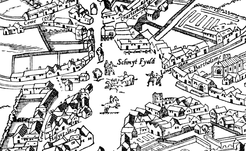 Civitas Londinum, 1561 Civitas Londinum, 1561 Like the lost River Fleet, another location in London that has long intrigued me is the infamous Smithfield market; a site of enormous contrasts: executions and extreme devotions, torture and merry-making. In the Middle Ages, Smithfield--"a smooth field" to the north of London's walls--was a natural place for jousts, tournaments, and the selling and butchering of livestock. Conveniently (!), animal waste from the market could be dumped into the River Fleet, which flowed into the Thames. It’s original origins as a place where livestock could be bought and sold, can be seen in the vestiges of its street names (e.g. Cow lane, Cock lane). 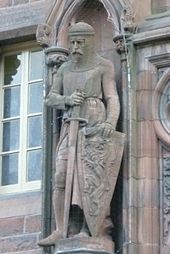 Wallace statue by D. W. Stevenson on the Scottish National Portrait Gallery, Edinburgh Wallace statue by D. W. Stevenson on the Scottish National Portrait Gallery, Edinburgh Not surprisingly, Smithfield, like most great open communal spaces was used for greatly varied purposes, including: Public torture: Over the centuries, many criminals—particularly those accused of treason—were tortured. One of the most famous was William Wallace (“Braveheart”)- - a twelfth century hero of the Scottish people. Drawing and quartered was the preferred method, and perhaps castrated as well (but studio executives probably thought movie audiences couldn’t stomach Mel Gibson undergoing that particular humiliation.) 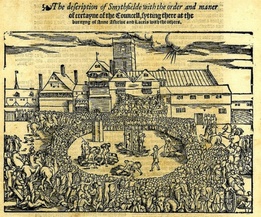 Public executions: While Smithfield was a regular site of hangings and burnings for centuries, under Queen Mary I (“Bloody Mary” to her detractors), quite a few Protestant dissenters were publicly burned as heretics. [Interesting side note: According to John Foxe’s Book of Martyrs, the “Marian Martyrs” would ask that their hands not be bound and their wood pile would consist of the greenest wood, so that their plaintive laments and prayers would last longer.) The burnings of these men and women were collectively referred to as “The Smithfield Fires.” Merry-making and Fair-going: Every August until the mid-seventeenth century, St. Bartholomew’s fair would be held at Smithfield. Originally it was supposed to be only three days of merry-making, but by the 17th century the fair was lasting over two weeks. Check out this advertisement for the entertainment to be had at the “Plow Music Booth” in 16xx: 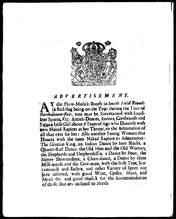 Anon (1679) Anon (1679) “At the Plow-Music Booth in Smith Field Rounds, (a Red flag being on the Top) during the Time of Bartholomew-Fair, you may be entertained with excellent sports, [such as] Antique dances, entries, cerebrands and jigs, a little girl about 6 years old who danceth with two naked rapiers at her throat, to the admiration of all that ever see her…. With good Wine, Cider, Mum and Mead, and good music for the accommodation of those who are inclined to mirth.” 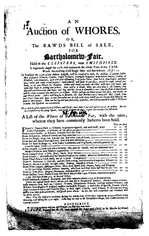 Altham, M. (1691) An auction of whores. Wing / 2858:01 Altham, M. (1691) An auction of whores. Wing / 2858:01 Or of course, for "all single men and bachelors," there was also an ongoing "auction of whores," which--as Michael Altham (1691) joked--contained, “a curious collection of painted whores, cracks, night-walkers, newgate-nappers, bridewell-workers, ladies of pleasue, cart-dancers; with other such dissembling pick-pocket cheats, some pox’d, some clap’d, and some quite rotten and ready to fall in pieces.” Underlying this bill, however a real fear of disease and pollution that seemed to occur whenever so many people were brought in such close proximity. King Charles I tried to cease the Fair on several occasions during his reign. In 1637, he issued a proclamation for putting off the Bartholomew Fair, and a similar fair in Southwark: 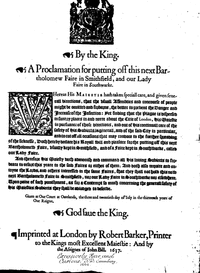 Printed by Robert Barker, 1637 Printed by Robert Barker, 1637 “Whereas his Majesty hath taken special care and given several directions, that the usual assemblies and concourse of people might be omitted and forborne, the better to prevent the danger and increase of the infection: Yet finding that the plague is dispersed in sundry places in and near the City of London, his majesty in pursuance of those direction and out of his continual care of the safety of his subjects in general, and of the said city in particular, and to cut off all occasions that may conduce to the further spreading of the sickness, doth hereby declare his royal will and pleasure for the putting off this next fair…” This was only a temporary halt to such festivities; only Cromwell was able to completely stop the fun. The Fair, like all other such festivals, was banned under his regime, only to be restored in 1666 with the Restoration of the fun-loving Charles II. 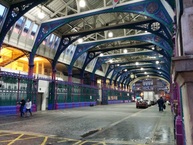 Smithfield Market today (credit: Greg Light) Smithfield Market today (credit: Greg Light) Today, there is little indication of the mass executions and torture that occurred here, although Smithfield Market—now called the Central London Market—is the largest of its kind in London, and one of the largest in all of the European Union. But like the River Fleet, the Smithfield grounds are another part of secret London.
1 Comment
Murder, Mayhem and a Midwife...An interview with historian Sam Thomas, author of The Midwife's Tale1/8/2013 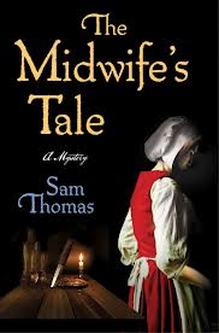 I'm excited to have historian Sam Thomas join me today to discuss his first novel, The Midwife's Tale, a historical mystery set in mid-seventeenth century York. Sam and I connected about a year ago, when we realized that (1) we're both trained as early modern English historians; (2) we both have debut novels coming out with Minotaur Books this year; and (3) both our mysteries are set in nearly the same time period. (I'm encouraging Sam to think about doing a cross-over piece, so that his midwife can bring my Lucy Campion into the world. But I digress.) -------------------------------------------------------------------------------------------------------- The Official Description: It is 1644, and Parliament’s armies have risen against the King and laid siege to the city of York. Even as the city suffers at the rebels’ hands, midwife Bridget Hodgson becomes embroiled in a different sort of rebellion. One of Bridget’s friends, Esther Cooper, has been convicted of murdering her husband and sentenced to be burnt alive. Convinced that her friend is innocent, Bridget sets out to find the real killer. Bridget joins forces with Martha Hawkins, a servant who’s far more skilled with a knife than any respectable woman ought to be. To save Esther from the stake, they must dodge rebel artillery, confront a murderous figure from Martha’s past, and capture a brutal killer who will stop at nothing to cover his tracks. The investigation takes Bridget and Martha from the homes of the city’s most powerful families to the alleyways of its poorest neighborhoods. As they delve into the life of Esther’s murdered husband, they discover that his ostentatious Puritanism hid a deeply sinister secret life, and that far too often tyranny and treason go hand in hand. -------------------------------------------------------------------------------------------------------- 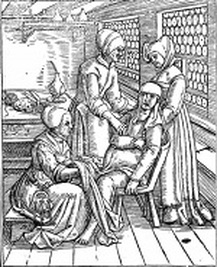 A midwife at work The Midwife's Tale is told through the first person perspective of Lady Bridget Hodgson, a 30-year old twice-widowed midwife and real historical figure. How much is known of the true Bridget, and how much of her personality/character did you invent? Did you ever feel constrained writing a fictionalized account of a real person? That’s a great question! We know a fair bit about Bridget, and I include some of it here. A lot of the basics are true: She was twice widowed, first to a man named Luke Thurgood, then to Phineas Hodgson, who was the son of the Lord Mayor of the York. (And yes, Phineas seems to have been every bit the loser I portray him as.) Bridget also had a deputy named Martha, though I had to invent much more of her background. It is also pretty clear that she was a very strong woman. She came from an ancient family and wanted people to know it. She also named all of her goddaughters (as well as her own daughter) ‘Bridget’, presumably after herself. Who does that? I did, however, make some cuts. For my first book I had a heck of a time writing her home life, so I made her childless, though the historical Bridget was survived by two daughters. There are also rumors that she had two sons, both of whom were hanged as highwaymen, which is amazing, but I’m not sure I believe it. 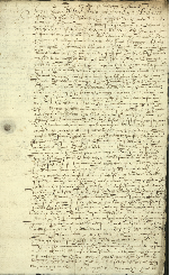 Bridget's Will Similarly, is the case at the heart of The Midwife's Tale based on a true case from the archives? How did you go about doing your research? The case itself is entirely fictional, though a lot of the supporting characters are real. As for the research it was a lot of digging. I stumbled across Bridget’s will when I was working on another project, and it provided dozens of names for me to chase down: friends, family, and best of all, godchildren, which allowed me to identify a handful of clients. Once you have names, you can then dig into baptismal registers, tax records, probate documents, legal records, histories of York…it’s endless, really. I also got very lucky that Bridget was once sued for defamation, which allowed me do dig even further into her social life and the history of her practice. Besides being a compelling read, your story gets at some of the larger historical themes around gender, politics and religion that shaped this time period. In what ways did you consciously try to illuminate these larger trends? How did you balance the need for historical accuracy with creative license? I consciously wanted to connect ‘big’ and ‘little’ history. The novel takes place in the midst of a rebellion against the king, so I made the crime at its heart a domestic rebellion in which a wife is accused of murdering her husband. This was a time when people were intensely concerned about maintaining order at the national and domestic levels, and I wanted to see how they would react when that order was challenged. (Oddly – or not – I do much the same thing in my historical work, favoring microhisotry, in which big stories are told through the lives of average individuals.) In doing your research, what was one of the most interesting things you learned? I think it was how complicated life as a midwife could be. Not only did they deliver children, they were part of the legal system, investigating crimes ranging from infanticide, to rape, to witchcraft. It really makes midwives the perfect sleuths! 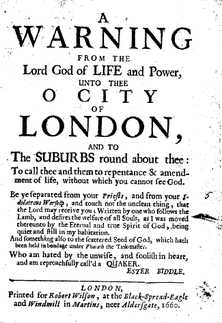 Esther Biddle, Quaker, 1660 This weekend I had the fun of seeing my first guest blog "Prophecy and Polemic— The Earliest Quaker Women" posted on the English Historical Fiction Authors website. There, I discuss why Quaker women were so political and how they differed in one particular way from most other women at the time--even members of other non-conformist sects (such as the Diggers, the Ranters, the Levelers etc). And oh! how they expressed themselves... Dressing in sack-cloth "Running naked as a sign" Refusing to bow to authority But that wasn't all... Quaker women were different because they wrote. And they wrote. And they wrote. And they wrote. In fact, as a group, Quaker women wrote 220 tracts before 1700, more than any other women. Petitions, broad-sides, chapbooks--all carrying admonitions to King, Parliament and clergy to recognize sinful acts, accounts of injustices and cruelties to their members, and pleas to release their religious brethren from prisons and authorize non-conformist worship in England, and the American colonies. I've always respected the bravery and creativity shown by the earliest Quakers, in their attempt to get their message heard. I've often thought how hard that must have been for them to write these open pieces. They were not just challenging Parliament, Magistrates, Churchmen and the King: they were challenging convention and the very heart of patriarchy, often risking public ridicule, shaming, abuses and imprisonment. Taking the mantles of Old Testament prophets, mid-seventeenth century Quaker women wrote openly about the social wrongs they perceived around them, especially those caused by the (imagined and real) abuses of men in power. In the soul-examining spirit of the time, Quaker women--like their male counterparts--also wrote publicly about their own struggles to find the "Inner Light" and to give up earthly fripperies. (Poor Susannah Whitrowe--she really wanted to cling to her ribbons, but knew she wasn't supposed to) They wrote about death and heartbreak, joy and promise. (This is not too suggest that they did not use their expressions of suffering to advance their cause--both politically and religiously--but there is an honesty to their expression that is admirable). At a time when women who wrote were disparaged as "petticoat authors," early Quaker women persevered to make their voices known. Just as they "ran naked as a sign" to convey their discontent to religious and secular authorities, they wrote nakedly too. They laid their emotions and concerns bare, for public consumption, expressing themselves in ways that were both daunting and inspiring. As I writer, I certainly struggle to lay my words bare on the page. Those little editorial voices are hard to muffle! I'm hoping, with time, to find my most authentic voice. How about you? I can't be the only one who's stared at "Dogs Playing Poker" wondering what the artist was thinking (or drinking, smoking, etc.) when he dreamed up this crazy, but fun, image. 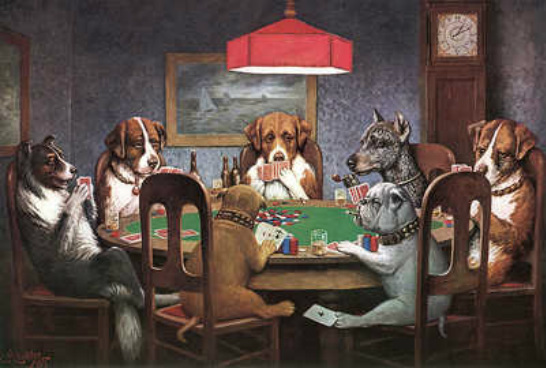 Exhibit A: "A Friend in Need" (part of "Dogs Playing Poker" series) Who doesn't love the bulldog passing his friend the ace? Pure unadulterated American kitch! Or is it???! I will call this painting Exhibit A. I ask you now to consider Exhibit B, below. 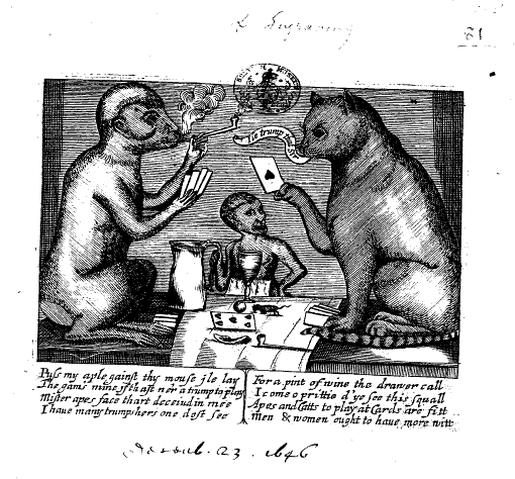 Exhibit B: Apes and cat playing poker (well, cards--there was no poker yet) Exhibit B was created by Anonymous in London 1646. Now, compare the two pieces carefully. Some differences...monkeys and cats, not dogs. A trumping card game, not poker. Some odd verse under the second one. But otherwise, Exhibit A and B are exactly the same, right? Both feature animals smoking, drinking, and, well, playing cards. An ace is prominent in both. Clearly, Coolidge's twentieth century collection was inspired by the seventeenth-century piece. No, I kid! When I came across Anonymous' (1646) woodcut, I was just struck by the superficial similarities to the more famous paintings. Actually, as you might surmise, since these two pieces had entirely different purposes and images, that it's rather silly to compare them. But I will anyway... As the story goes, C.M. Coolidge was commissioned by an advertising firm, Browne and Bigelow, in 1903 to create the iconic series of oil paintings, collectively called "Dogs Playing Poker." The purpose was to sell cigars. (In Exhibit A, after the viewer takes in the ace, his or her eye will also be drawn to the smoking pipe just behind it). On the other hand, the Thomason Tracts catalog says the woodcut in Exhibit B is "An engraving representing a monkey and a cat playing at cards; with descriptive verses denouncing card-playing." The text underneath the image reads: "Puss my aple gainst thy mouse Ile lay The gam's mine ifth aft n'er a trump to play. Mister apes face tart deceived in mee I have many trumpsters one dost see. For a pint of wine the drawer call I come o prittie d'ye see this squall Apes and catts to play at cards are fitt Men and women ought to have more witt." Huh? Basically, Anonymous was taking a good Puritan stance against card playing; after all, Cromwell's Parliament had banned all gambling and gaming by the mid-seventeenth century. And nothing depicts moral decay and mental decline more readily than apes and a cat playing cards. So maybe the two pieces had different--okay, completely opposite--messages. Or-r-r-r, maybe we've hit on the secret seventeenth-century Puritanical origins of "Dogs Playing Poker." What do you think? You tell me! 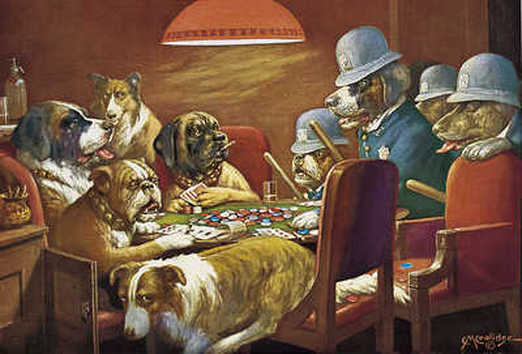 (And just because these are so much fun, I'll leave you with "Pinched with Four Aces" to ponder. Discuss amongst yourselves!) |
Susanna CalkinsHistorian. Mystery writer. Researcher. Teacher. Occasional blogger. Categories
All
Archives
May 2023
|
 RSS Feed
RSS Feed